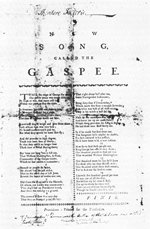The Gaspee Days Committee at www.gaspee.COM is a civic-minded nonprofit organization that operates many community events in and around Pawtuxet Village, including the famous Gaspee Days Parade each June. These events are all designed to commemorate the burning of the hated British revenue schooner, HMS Gaspee, by Rhode Island patriots in 1772 as 'America's First Blow for Freedom'®. Our historical research center, the Gaspee Virtual Archives at www.gaspee.ORG , has presented these research notes as an attempt to gather further information on the the burning of the Gaspee. Please e-mail your comments or further questions to webmaster@gaspee.org.
 Right: A photograph of the printed
poem on the burning of the
Gaspee
is presented on page 53 of Florence Parker Simister's The Fire's
Center,
Rhode Island in the Revolutionary Era 1763-1790. RI Bicentennial
Foundation,
1979.
Right: A photograph of the printed
poem on the burning of the
Gaspee
is presented on page 53 of Florence Parker Simister's The Fire's
Center,
Rhode Island in the Revolutionary Era 1763-1790. RI Bicentennial
Foundation,
1979. An Analysis of the Handwriting on the Published Poem
Of interest, the name of Theodore Fo(s)ter's is scripted at the top
of this poem, and its presence leads to some mystery. It could be
simply a handwritten name of someone who purchased the published poem,
but logic would state that one does not usually place an apostrophe s
when
marking one's possessions. The top script is perfectly
parallel
to the accompanying typeset, and and attempt has been made to center it
on the page by extending the signature line after the apostrophe
s.
It appears to be as dark and as unfaded as the typeset, indicating that
the publisher of the poem may have included the author's name in script
at the top.
Note also that the ink is darker, of different handwriting, and the
script size much larger than the handwritten note at the bottom. The
note
at the bottom is not completely decipherable, even with digital
magnification.
To the best of my ability it appears to state:
"If I remember"! (unintelligible capitalized name, possibly
Quin) . was the (author)/(brother) of the above one
of
the sixty-four? Presented to RI Hist. Society by (unintelligible,
possibly J____ Hereshoff).
According to the invaluable RI Historical Cemeteries Project at http://www.rootsweb.com/~rigenweb/cemetery/cemetery282.html there are no Quins or Quinns buried in Rhode Island that were alive during the burning of the Gaspee, most having come over from Ireland in the late nineteenth century. Of course that doesn't entirely preclude that there may have been Quins living in Rhode Island at the time. The first letter could be a Q but might be a D. If you stretch your imagination, it could be Dunn, and a Dunn was a known participant in the attack, having been named by both Ephraim Bowen and John Mawney.
Note that the RI Historical Society was not incorporated until 1822. Again, looking through the RI Historical Cemeteries Project at http://www.rootsweb.com/~rigenweb/cemetery/cemetery166.html we find that there are at least two possibilities on the donor, John Brown Hereshoff (1805-1861) and Julia Anne Hereshoff (1811-1901) who were both living during the earliest years of the RI Historical Society, and would've been able to make the donation of this copy of the Gaspee poem. The donor may not have been the same person to write down the name of who actually gave the poem, and this writing appears to be smaller and lighter than the writing before it.
Who was Theodore Foster?
See his bio at: TheodoreFoster.htm
Who was Samuel Dunn?
See: SamuelDunn.htm
Ah, yes, but there have been other claims as to authorship of the
Gaspee
Song
Yes, indeed. It has long been a tradition (apparently from several
sources) that the author of the Gaspee "Song" was one of the Gaspee
raiders. This tradition may have started with this handwritten note at
the bottom of the poem as presented above. Wilfred Munro in his Tales
of an Old Sea Port makes the claim that the "lyric to
commemorate
the affair came from the pen of Captain Thomas Swan of Bristol,
(see
ThomasSwan.htm )one of those who took part
in it." He goes on to present the Gaspee "Song" that is
presented
above in The History of Bristol, R.I.- The
Story
of Mount Hope Lands. He also claims that the Gaspee
"Song"
was discovered attached to the back of a family portrait of Thomas
Swan.
At the present time Captain Swan has been the person most credited with
writing this poem.....but did he? Note that there is no publication
date
on the printed poem, and the publisher probably wouldn't have dared to
print it until at least after the 1776 Declaration of
Independence.
It is quite possible that Swan handwrote his copy of the poem because
no
printed copies were available. It could just as easily be surmised that
Swan read or heard the poem, wrote it down in his own handwriting, and
enjoyed reciting it at family gatherings. Over the generations,
the
Swan family from Bristol undoubtedly came to believe that Captain
Thomas
Swan wrote the poem himself. This claim was probably passed onto Munro
when he did his historical research some 88 years after the burning of
the Gaspee. And note that Munro, writing in his 1860 The
History of Bristol, R.I.- The Story of Mount Hope Lands, attributes
Swan as the author; this is not quite as strong a connotation as saying
Swan was the author. This discussion is not
meant
to to imply in any way that Captain Swan did not participate in the
attack
on the Gaspee, but only to raise the question of whether he was
the actual author of the Gaspee "Song".
So who actually wrote the Gaspee "Song" and, by tradition
therefore, is also implicated as one of the Gaspee Raiders?
Weighing all the evidence, it appears most likely that this was US
Senator Theodore Foster. But while he may have written the poem, it is
very doubtful that he was part of the raid.